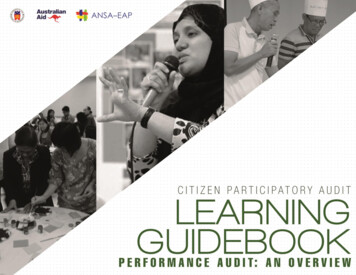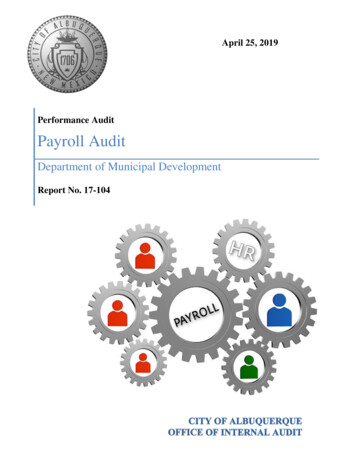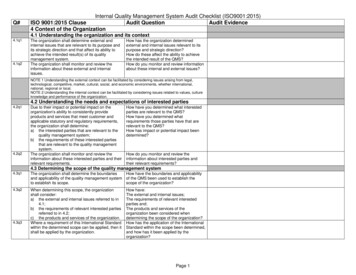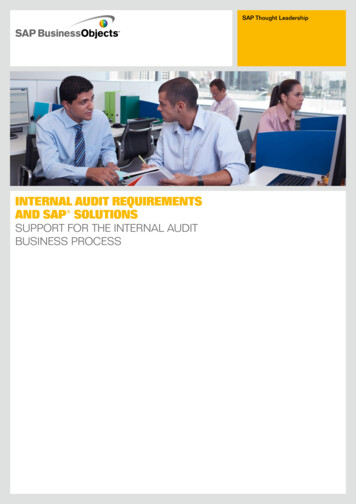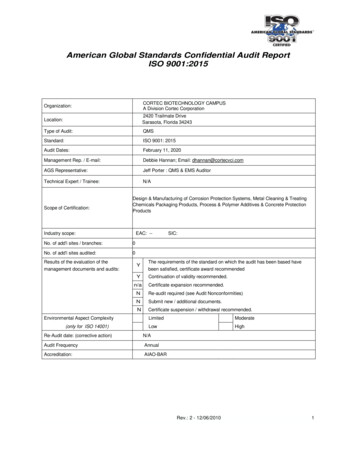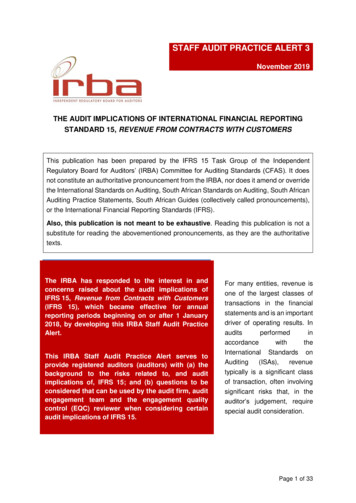
Transcription
STAFF AUDIT PRACTICE ALERT 3November 2019THE AUDIT IMPLICATIONS OF INTERNATIONAL FINANCIAL REPORTINGSTANDARD 15, REVENUE FROM CONTRACTS WITH CUSTOMERSThis publication has been prepared by the IFRS 15 Task Group of the IndependentRegulatory Board for Auditors’ (IRBA) Committee for Auditing Standards (CFAS). It doesnot constitute an authoritative pronouncement from the IRBA, nor does it amend or overridethe International Standards on Auditing, South African Standards on Auditing, South AfricanAuditing Practice Statements, South African Guides (collectively called pronouncements),or the International Financial Reporting Standards (IFRS).Also, this publication is not meant to be exhaustive. Reading this publication is not asubstitute for reading the abovementioned pronouncements, as they are the authoritativetexts.[SIDEBAR TITLE]The IRBA has responded to the interest in andconcerns raised about the audit implications ofIFRS 15, Revenue from Contracts with Customers(IFRS 15), which became effective for annualreporting periods beginning on or after 1 January2018, by developing this IRBA Staff Audit PracticeAlert.This IRBA Staff Audit Practice Alert serves toprovide registered auditors (auditors) with (a) thebackground to the risks related to, and auditimplications of, IFRS 15; and (b) questions to beconsidered that can be used by the audit firm, auditengagement team and the engagement qualitycontrol (EQC) reviewer when considering certainaudit implications of IFRS 15.For many entities, revenue isone of the largest classes oftransactions in the financialstatements and is an importantdriver of operating results. InauditsperformedinaccordancewiththeInternational Standards onAuditing(ISAs),revenuetypically is a significant classof transaction, often involvingsignificant risks that, in theauditor’s judgement, requirespecial audit consideration.Page 1 of 33
BACKGROUNDIRBA1.In March 2019, the CFAS agreed to commence a project to develop audit relatedguidance on the audit of transactions, account balances and disclosures accounted forin terms of IFRS 15.2.The IRBA has been monitoring developments in terms of auditing guidance issued onIFRS 15 by National Standards Setters (NSS) and audit firms. The Secretariat alsoengaged in discussions with the South African Institute of Chartered Accountants(SAICA), the IRBA’s Inspections department and audit firms (small and medium-sizedaudit firms and the big four firms) to identify areas where further guidance is required.3.The IRBA hosted a meeting in July 2019 to discuss the audit related guidance requiredon IFRS 15 and also to: Understand from the audit firms (represented by Audit Technical and AccountingTechnical specialists) their progress made in embedding the audit of IFRS 15transactions, account balances and disclosures into their audit engagements; Understand international developments regarding the issuing of audit relatedguidance on IFRS 15; Discuss challenges faced by auditors in auditing IFRS 15 transactions, accountbalances and disclosures; Understand what guidance has been issued by audit firms (both locally andinternationally and network firms, where applicable) internally on auditing IFRS 15transactions, account balances and disclosures; Discuss some preliminary views on the type of guidance that might be necessaryon the audit implications of IFRS 15.4.The IRBA Public Inspections Report 2017/2018 highlighted that the IRBA continues tofocus on revenue recognition as a significant risk area. This is due to the fact that inmost businesses revenue is not only quantitatively material but is key to the business.The IRBA Inspections department has identified deficiencies in the audit workperformed with respect to revenue across all assertions.5.New accounting standards have a history of implementation challenges. This IRBAStaff Audit Practice Alert aims to be more proactive in helping auditors audit IFRS 15transactions, account balances and disclosures.What is new in IFRS 15?6.In May 2014, the International Accounting Standards Board (IASB) issued IFRS 15. Inbrief, IFRS 15 replaced International Accounting Standard (IAS) 11, ConstructionContracts, IAS 18, Revenue, International Financial Reporting InterpretationsCommittee (IFRIC) 13, Customer Loyalty Programmes, IFRIC 15, Agreements for theConstruction of Real Estate, IFRIC 18, Transfers of Assets from Customers andPage 2 of 33
Standard Interpretations Committee (SIC) 31, Revenue – Barter TransactionsInvolving Advertising Services. IFRS 15 provides a comprehensive framework forrecognising revenue from contracts with customers.7.IFRS 15 became effective for annual reporting periods beginning on or after 1 January2018, with early adoption permitted. This effective date also applies to entities thatapply IFRSs in South Africa.8.IFRS 15 establishes the principles that an entity applies when reporting informationabout the nature, amount, timing and uncertainty of revenue and cash flows from acontract with a customer. In applying IFRS 15, an entity recognises revenue to depictthe transfer of promised goods or services to the customer in an amount that reflectsthe consideration to which the entity expects to be entitled to in exchange for thosegoods or services.9.This change in the framework for recognising revenue from the traditional “risks andrewards” approach in IAS 18 impacts how an auditor audits revenue from contractswith customers.10.According to IFRS 15.5, an entity shall apply IFRS 15 to all contracts with customers,except the following:11. Lease contracts within the scope of IFRS 16, Leases; Contracts within the scope of IFRS 17, Insurance Contracts. However, an entitymay choose to apply IFRS 15 to insurance contracts that have as their primarypurpose the provision of services for a fixed fee in accordance with paragraph 8of IFRS 17; Financial instruments and other contractual rights or obligations within thescope of IFRS 9, Financial Instruments, IFRS 10, Consolidated FinancialStatements, IFRS 11, Joint Arrangements, IAS 27, Separate FinancialStatements and IAS 28, Investments in Associates and Joint Ventures; and Non-monetary exchanges between entities in the same line of business tofacilitate sales to customers or potential customers. For example, IFRS 15would not apply to a contract between two oil companies that agree to anexchange of oil to fulfil demand from their customers in different specifiedlocations on a timely basis.An entity shall apply IFRS 15 to a contract (other than a contract listed in paragraph 5of IFRS 15) only if the counterparty to the contract is a customer. A customer is a partythat has contracted with an entity to obtain goods or services that are an output of theentity’s ordinary activities in exchange for consideration. A counterparty to the contractwould not be a customer if, for example, the counterparty has contracted with the entityto participate in an activity or process in which the parties to the contract share in therisks and benefits that result from the activity or process (such as developing an assetin a collaboration arrangement) rather than to obtain the output of the entity’s ordinaryactivities (IFRS 15.6).Page 3 of 33
12.IFRS 15.7 states that a contract with a customer may be partially within the scope ofthis Standard and partially within the scope of other Standards listed in paragraph 5 ofIFRS 15. If the other Standards specify how to separate and/or initially measure one ormore parts of the contract, then an entity shall first apply the separation and/ormeasurement requirements in those Standards. An entity shall exclude fromthe transaction price the amount of the part (or parts) of the contract that areinitially measured in accordance with other Standards and shall applyparagraphs 73–86 of IFRS 15 to allocate the amount of the transaction pricethat remains (if any) to each performance obligation within the scope of IFRS15 and to any other parts of the contract identified below. If the other Standards do not specify how to separate and/or initially measureone or more parts of the contract, then the entity shall apply IFRS 15 to separateand/or initially measure the part (or parts) of the contract.13.IFRS 15 specifies the accounting for the incremental costs of obtaining a contract witha customer and for the costs incurred to fulfil a contract with a customer if those costsare not within the scope of another Standard (see paragraphs 91–104 of IFRS 15). Anentity shall apply those paragraphs only to the costs incurred that relate to a contractwith a customer (or part of that contract) that is within the scope of IFRS 15 (IFRS 15.8).14.To recognise revenue under IFRS 15, an entity applies the following five steps: Identify the contract(s) with a customer; Identify the performance obligations in the contract; Determine the transaction price; Allocate the transaction price to each performance obligation; and Recognise revenue when a performance obligation is satisfied.15. As it is evident, the audit of revenue transactions, account balances and disclosuresencompasses the consideration of a number of estimates. The recent InternationalAuditing and Assurance Standards Board’s (IAASB) pronouncement, ISA 540 (Revised),Auditing Accounting Estimates and Related Disclosures (ISA 540 (Revised)), issued on3 October 2019, provides insights (requirements and application material) that are alsorelevant to the audit of revenue transactions, account balances and disclosures.ISA 540 (Revised)16.The IRBA Board approved ISA 540 (Revised) for adoption, issue and prescription foruse by registered auditors in South Africa at its meeting on 6 November 2018.17.The revisions to ISA 540 (Revised) include those that are responsive to the significantlocal and international inspection findings on the audit of accounting estimates.Page 4 of 33
18.ISA 540 (Revised) is effective for financial statement audits for periods beginning onor after 15 December 2019. Early adoption of ISA 540 (Revised) is permissible and isencouraged by the IRBA.19.Some of the significant revisions include: An enhanced risk assessment that requires auditors to consider complexity,subjectivity and other inherent risk factors in addition to estimation uncertainty. Thiswill drive auditors to think more deeply about the risks inherent to accountingestimates. A closer link between the enhanced risk assessment and the methods, data andassumptions used in making accounting estimates, including the use of complexmodels.20. A requirement for a separate assessment of inherent risk and control risk. Specific material to show how the standard is scalable to all types of accountingestimates. Emphasis on the importance of applying appropriate professional scepticism whenauditing accounting estimates to foster a more independent and challengingsceptical mind-set in auditors. An example is the introduction of a 'stand-back'requirement or 'overall evaluation based on audit evidence obtained' that requiresauditors to take into account all relevant audit evidence obtained, whethercorroborative or contradictory.The ISA 540 (Revised) Implementation project page has been added to the IAASBwebsite as a repository for implementation support materials. It contains links to usefulmaterials and will continue to be updated. Please visit the ISA 540 (Revised)Implementation project page regularly to check whether any new implementationsupport has been issued by the ISA 540 (Revised) Implementation Working Group.Page 5 of 33
QUESTIONS TO BE CONSIDERED21.The questions to be considered can be used by the audit firm, audit engagement team and the engagement quality control (EQC) reviewerwhen considering the audit implications of IFRS 15. It, however, is not an exhaustive list of considerations and should not take away fromthe requirements of the audit engagement team to exercise their professional judgement.22.In consideration of and response to the different content elements and questions posed in the “questions to be considered” section, theengagement team should be guided by the requirements and application material contained in the relevant ISAs.23.The “questions to be considered” section contains questions to be responded to at the “Firm Level” and at the “Engagement Level”. The“Firm Level” questions are to be considered and responded to by the audit firm’s leadership that has the responsibility to consider theaudit implications of new accounting standards at the audit firm level (or its equivalent). The “Engagement Level” questions are to beconsidered and responded to by the audit engagement team on each engagement.24.For each consideration of the content elements and questions posed in the “questions to be considered” section, auditors are to considerdeveloping an appropriate response.25.Auditors are reminded of their responsibility to prepare audit documentation, on a timely basis, for an audit of financial statements1. Theobjective of the auditor is to prepare documentation that provides:1 A sufficient and appropriate record of the basis for the auditor’s report; and Evidence that the audit was planned and performed in accordance with ISAs and applicable legal and regulatory requirements.ISA 230, Audit DocumentationPage 6 of 33
Questions to be considered2FIRM LEVEL23Reference to ENGAGEMENT LEVELISA/OtherReference toISA/Other1.Firm level risk management process considerations, including multi-location and multi-national considerations-Has your firm determined, through its risk assessment ISQC 13procedures, which of its audit clients IFRS 15 affectsand the possible impact?-Has your firm made any changes to its riskmanagement processes as a result of the auditimplications of IFRS 15?-Has your firm provided relevant guidance on the riskassessment process to network firm offices in thevarious jurisdictions?2.Acceptance and continuance of client relationships and specific engagements, including human resources considerations-Has your firm established policies and procedures for ISQC 1the acceptance and continuance of client relationshipsand specific engagements, designed to provide thefirm with reasonable assurance that the firm will onlyundertake or continue relationships and engagementswhere the firm is competent to perform theengagement and has the capabilities, including timeand resources, to audit the implications of IFRS 15?For each consideration of the content elements and questions posed in the “questions to be considered” section, auditors are to consider developing anappropriate response.International Standard on Quality Control 1 (ISQC 1), Quality Control for Firms that Perform Audits and Reviews of Financial Statements, and OtherAssurance and Related Services EngagementsPage 7 of 33
Questions to be considered2FIRM LEVEL45678Reference to ENGAGEMENT LEVELISA/OtherReference toISA/Other-Has your firm established policies and proceduresdesigned to provide it with reasonable assurance thatit has sufficient personnel with the competence,capabilities and commitment to ethical principlesnecessary to perform engagements in accordance withprofessional standards and applicable legal andregulatory requirements, in particular to audit theimplications of IFRS 15?3.Ethical considerations when an audit firm is engaged to consult with an entity on the development of their revenue models andthe potential of a self-review threat (i.e. non-assurance services)-Has your firm put in place client and engagement ISQC 1acceptance procedures that address the risk of -Has your firm implemented appropriate safeguards?-Has your firm considered if there is sufficient capacityto perform the non-assurance engagement?NOTE: Throughout the audit engagement, theengagement partner shall remain alert, throughobservation and making inquiries as necessary,for evidence of non-compliance with relevantethical requirements by members of theengagement team.-ISA 2104ISA 2205ISA 2506ISA 315(Revised) 7Have you considered whether there are any IRBA Code8services prohibited in terms of the Section 600Companies Act?ISA 210, Agreeing the Terms of Audit EngagementsISA 220, Quality Control for an Audit of Financial StatementsISA 250, Consideration of Laws and Regulations in an Audit of Financial StatementsISA 315 (Revised), Identifying and Assessing the Risks of Material Misstatement Through Understanding the Entity and its EnvironmentIRBA Code of Professional Conduct for Registered Auditors (Revised November 2018) (IRBA Code)Page 8 of 33
Questions to be considered2FIRM LEVEL-Reference to ENGAGEMENT LEVELISA/OtherHave you considered the extent to which theindependence provisions apply to your network firmoffices?Reference toISA/Other-Have you considered whether there are any Companiesprohibitions provided for in the IRBA Code in Act, 20089particular with regard to the development offinancial systems of the entity?-Have you considered whether there are anyother restrictions prescribed by otherregulators?-Have you discussed with and obtainedapproval for non-assurance engagementsfrom those charged with governance(TCWG)?4.Considerations of other interventions that an audit firm and the engagement team can put in place to address the auditimplications of IFRS 15-Has your firm developed policies and procedures for ISQC 1hiring and/or collaborating with appropriate skilledresources?-910Has your firm developed policies and procedures fortraining requirements on the audit implications ofIFRS 15?--Have you considered the skills set of theengagement team, including the use ofaccounting specialists required to performthe audit of IFRS 15 transactions, accountbalances and disclosures?ISA 220ISA 315(Revised)ISA 540(Revised)Does your engagement quality control10reviewer have sufficient and appropriate ISA 620Companies Act, 2008 (Act No. 71 of 2008)ISA 620, Using the Work of an Auditor’s ExpertPage 9 of 33
Questions to be considered2FIRM LEVEL-Reference to ENGAGEMENT LEVELISA/OtherHas your firm developed policies and procedures forsourcing data, such as fair values for non-cashconsideration (or promise of non-cash consideration)?Reference toISA/Otherexperience and authority to review IFRS 15transactions,accountbalancesanddisclosures?-Have you considered firm-specific guidanceissued within your network firm offices to usein auditing IFRS 15 transactions, accountbalances and disclosures?-Have you considered a similar completedaudit engagement that applied IFRS 15within your firm or network firm offices to useas a reference?-Have you considered the use of an auditor’sexpert in auditing IFRS 15 transactions,account balances and disclosures?-Have you considered discussing entityspecificrevenueimplicationswithmanagement and your audit team?Page 10 of 33
Questions to be considered2FIRM LEVELReference to ENGAGEMENT LEVELISA/Other5.Considerations for the audit of transition adjustments and disclosures made by entities in terms of IFRS 15-Does your firm have the ability to audit the disclosure ISQC 1of known or reasonably estimable information (financialand non-financial) relevant to assessing the impact ofIFRS 15 in the period of initial application?NOTE: During the transition to IFRS 15, someentities might utilise spreadsheets and othershort-term manual processes until automatedprocesses and controls are implemented. Theseshort-term manual processes may presentdifferent or greater risks of material misstatementthan automated processes subject to effectiveInformation Technology General Controls.Reference toISA/OtherISA 315(Revised)ISA 540(Revised)NOTE: Auditors are reminded to consider thealignment between the interim reported resultsand year-end reporting financial statements.Misalignment may occur in: The initial financial determination of theimpact of the new standard as disclosed inthe interim reported results versus thefinancial determination as disclosed in theyear-end financial statements; or Disclosures that were either omitted orincorrectly provided in the interim reportedresults.Page 11 of 33
Questions to be considered2FIRM LEVELReference to ENGAGEMENT LEVELISA/OtherReference toISA/OtherFirst time adoption for year-end reportingpurposes11-Have you considered the requirements asoutlined in IFRS 15 Appendix C11, and IAS 8,where applicable, relating to transitionadjustments and disclosures?-Have you considered whether the entityused the full or modified retrospectivetransition method for applying IFRS 15?-Have you identified and assessed the risksof material misstatement associated with Have you considered, in assessing andresponding to the risks of materialmisstatement of the transition adjustments,the following: Data that may not have been auditedpreviously; Prior-period misstatements identifiedin the current period’s audit?IFRS 15 Appendix C, Effective date and transitionPage 12 of 33
Questions to be considered2FIRM LEVELReference to ENGAGEMENT LEVELISA/Other--Reference toISA/OtherHave you considered internal controls overthe transition adjustments and disclosures,including, but not limited to: The transfer of data from old to newsystems? The changes to existing systems thatwould have to be tested? The inclusion of new systems?Have you considered whether theinformation gathered in obtaining anunderstanding of the entity’s transitionadjustments indicates the presence of one ormore fraud risk factors, and whether theseshould be taken into account in identifyingand assessing fraud risks? Refer tosection 7 below.-Is the entity providing the disclosures asrequired by IFRS 15 Appendix C, and IAS 8,where applicable, relating to transitionadjustments and disclosures, when it hasadopted IFRS 15?Page 13 of 33
Questions to be considered2FIRM LEVELReference to ENGAGEMENT LEVELISA/Other-Reference toISA/OtherIn instances where you have concluded thatdisclosures in the financial statements areomitted, incomplete or inaccurate, have youevaluated the effect on the financialstatements and the auditor’s report? Refer tosection 17 below.First time adoption for interim reportingpurposes6.-Have you considered the implications oninterim reported results in the year ofadoption of IFRS 15?-Have you considered the requirements asoutlined in IAS 3412 relating to changes inaccounting policies?Considerations on identifying relevant assertions and risks of material misstatement, including significant risksNOTE: Auditors are reminded that for significant ISA 315risks, including fraud risks, they are required to (Revised)perform substantive procedures that areISA 33013specifically responsive to the assessed risks.1213IAS 34, Interim Financial ReportingISA 330, The Auditor’s Responses to Assessed RisksPage 14 of 33
Questions to be considered2FIRM LEVELReference to ENGAGEMENT LEVELISA/Other-Have you considered a similar completedaudit engagement that applied IFRS 15within your firm or network firm offices to useas a reference for identifying relevantassertionsandrisksofmaterialmisstatement, including significant risks?-Haveyouobtainedtherequiredunderstanding of the entity and itsenvironment, including the entity’s internalcontrol?-Have you obtained an understanding of theentity’s revenue streams?-Have you identified and assessed the risksof material misstatement associated with theentity’s application of IFRS 15?-Have you determined whether any of therisks identified are, in the auditor’sjudgement, a significant risk?Reference toISA/OtherPage 15 of 33
Questions to be considered2FIRM LEVEL7.Reference to ENGAGEMENT LEVELISA/Other-In instances where you have determined thata significant risk exists, have you obtainedan understanding of the entity’s controls,including control activities, relevant to thatrisk?-In circumstances where you have obtainedaudit evidence from performing further auditprocedures, or if new information isobtained, either of which is inconsistent withthe audit evidence on which the auditororiginally based the assessment, have yourevised the assessment and modified nce toISA/OtherIdentifying and assessing fraud risksNOTE: Identifying specific fraud risks arising ISA 20014from implementation of IFRS 15 involves havingISA 23015a sufficient understanding of the standard as well16as the entity’s processes, systems, and controls ISA 240over its implementation of the standard.141516ISA 200, Overall Objectives of the Independent Auditor and the Conduct of an Audit in Accordance with International Standards on AuditingISA 230, Audit DocumentationISA 240, The Auditor’s Responsibilities Relating to Fraud in an Audit of Financial StatementsPage 16 of 33
Questions to be considered2FIRM LEVELReference to ENGAGEMENT LEVELISA/OtherReference toISA/OtherNOTE: Opportunities for fraud in implementing ISA 315IFRS 15 may arise in the development of (Revised)significant new accounting estimates orjudgement, or due to control deficiencies thatmight result from changes made to systems,processes, and controls to implement IFRS 15.-Haveyoumaintainedprofessionalscepticism throughout the audit, recognisingthe possibility that a material misstatementdue to fraud could exist, notwithstandingyour past experience of the honesty andintegrity of the entity’s management andTCWG?-Have you considered the ways managementcould intentionally misstate revenue andrelated accounts and how they mightconceal such misstatements?-Have you, as part of the identification offraud risks, also considered the risk ofmanagement override of controls?Page 17 of 33
Questions to be considered2FIRM LEVELReference to ENGAGEMENT LEVELISA/Other-Have key engagement team members,includingtheengagementpartner,brainstormed about how and where theybelieve the entity's revenue and relatedaccounts might be susceptible to fraud?-Have you discussed how management couldperpetrate and conceal fraud, including byomitting or presenting incomplete orinaccurate disclosures?-Have you presumed that there is a fraud riskinvolving improper revenue recognition? Ifyes, have you evaluated which types ofrevenue, revenue transactions, or assertionsmay give rise to such risks?-Where you have concluded that thepresumption that there is a risk of materialmisstatement due to fraud related to revenuerecognition is not applicable in thecircumstances of the engagement, have youincluded the reasons for that conclusion inthe audit documentation?Reference toISA/OtherPage 18 of 33
Questions to be considered2FIRM LEVEL8.Reference to ENGAGEMENT LEVELISA/OtherReference toISA/OtherConsiderations on the audit of the five step IFRS 15 revenue modelIdentifying the contractISA 200-Have you considered whether the criteria in ISA 315(Revised)IFRS 15 for a contract are met?-Have you considered the following:ISA 50017 Verbal contracts;ISA 52018 Contract modifications; Contract combinations;ISA 700(Revised)19 Principal versus agent; and/or Contractspractices?impliedbybusinessIdentifying performance obligations-Have you considered what the entitypromises to transfer to the customer atcontract inception, and whether each ofthese are distinct performance obligations?171819ISA 500, Audit EvidenceISA 520, Analytical ProceduresISA 700 (Revised), Forming an Opinion and Reporting on Financial StatementsPage 19 of 33
Questions to be considered2FIRM LEVELReference to ENGAGEMENT LEVELISA/Other-Reference toISA/OtherHave you considered whether a series ofdistinct goods or services are substantiallythe same and have the same pattern oftransfer to the customer?Determining the transaction price-Have you considered the terms of thecontract and the entity’s customary businesspractices to determine the transaction price?-Have you considered the following: Existence of a significant financingcomponent in the contract; Whether the consideration promised ina contract includes a variable amount; Whether the consideration promised ina contract includes a non-cashconsideration; Whether there is a considerationpayable to a customer; and/or Refund liabilities?Page 20 of 33
Questions to be considered2FIRM LEVELReference to ENGAGEMENT LEVELISA/OtherAllocatingthetransactionperformance obligationsReference toISA/Otherpriceto-Have you considered the stand-alone sellingprice at contract inception of the distinctgoodorserviceunderlyingeachperformance obligation in the contract?-Have you considered whether the standalone selling price is directly observable?-Have you considered whether there is anallocation of a discount (where the sum ofthe stand-alone selling prices of thosepromised goods or services in the contractexceeds the promised consideration in acontract)?Recognise revenue-When considering how the entity satisfies aperformance obligation by transferring apromised good or service to a customer: Have you considered whether thecriteria for recognising revenue overtime have been met?Page 21 of 33
Questions to be considered2FIRM LEVELReference to ENGAGEMENT LEVELISA/Other -Reference toISA/OtherIf the criteria for recognising revenueover time is not met, have youconsidered at what point in timerevenue is recognised?Have you considered how progress towardscomplete satisfaction of a performanceobligation is measured? Refer to section 11below.Other considerations--Have you considered whether the followinghas been recognised in conformity withIFRS 15: Incremental costs of obtaining acontract; and/or Costs to fulfil a contract?In instances where you have concluded thatrevenue has been omitted, or that revenue isincomplete or inaccurate, have youevaluated the effect on the financialstatements and the auditor’s report? Refer tosection 17 below.Page 22 of 33
Questions to be considered2FIRM LEVEL9.Reference to ENGAGEMENT LEVELISA/OtherReference toISA/OtherConsiderations for how and on what an auditor should apply professional scepticism in “challenging” their clients, regardingrevenue recognition- Has your firm developed and issued guidance o
10. According to IFRS 15.5, an entity shall apply IFRS 15 to all contracts with customers, except the following: Lease contracts within the scope of IFRS 16, Leases; Contracts within the scope of IFRS 17, Insurance Contracts. However, an entity may choose to apply IFRS 15





